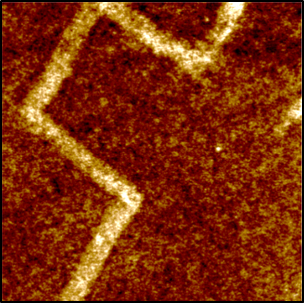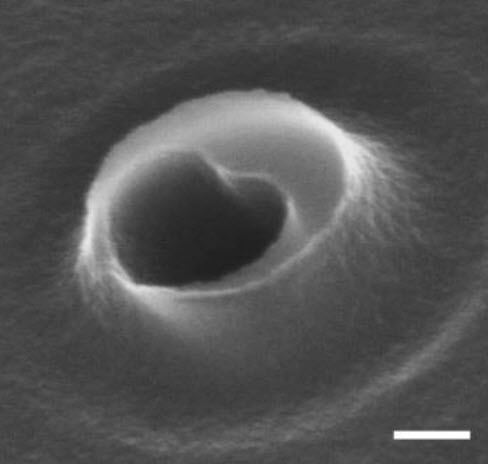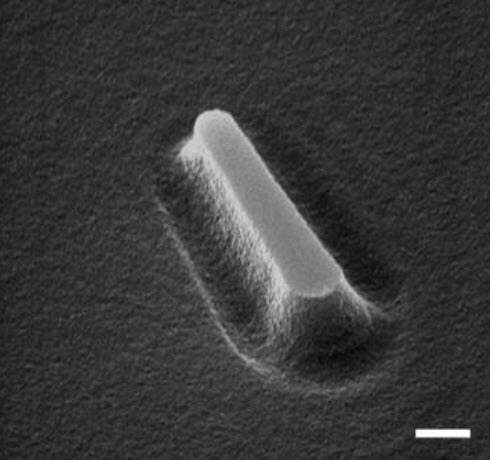‘Nanomotor lithography’ provides simpler, affordable nanofabrication
November 3, 2014

Nanoengineers have invented a spherical nanorobot made of silica that focuses light like a near-field lens to write surface patterns for nanoscale devices. In this image, the red and purple-blue areas indicate where the light is being magnified to produce a trench pattern on light-sensitive material. (Credit: Laboratory for Nanobioelectronics, UC San Diego Jacobs School of Engineering)
Nanoengineers at the University of California, San Diego recently invented a new lithography method for creating nanoscale electronic and medical devices, using nanorobots (nanomotors) that are chemically powered, self-propelled, and magnetically controlled.
These nanorobots swim over the surface of light-sensitive material to create complex surface patterns.
Their research, published recently in the journal Nature Communications, offers a simpler and more affordable alternative to the high cost and complexity of current state-of-the-art nanofabrication methods, such as electron beam writing, the researchers say.
Led by distinguished nanoengineering professor and chair Joseph Wang, the team developed, the team’s proof-of-concept study demonstrates the first nanorobot swimmers able to manipulate light for nanoscale surface patterning. The new strategy combines controlled movement with unique light-focusing or light-blocking abilities of nanoscale robots.

An AFM image of a square-wave pattern written by a rod-shaped nanowire robot for nanoscale device manufacturing (credit: Lab. for Nanobioelectronics, UC San Diego Jacobs School of Engineering)
“All we need is these self-propelled nanorobots and UV light,” said Jinxing Li, a doctoral student at the Jacobs School of Engineering and first author. “They work together like minions, moving and writing and are easily controlled by a simple magnet.”
As scientists invent devices and machines on the nanoscale, there is new interest in developing unconventional nanoscale manufacturing technologies for mass production.
State-of-art lithography methods such as electron beam writing are used to define extremely precise surface patterns on substrates used in the manufacture of microelectronics and medical devices.
These patterns form the functioning sensors and electronic components such as transistors and switches packed on today’s integrated circuits.

An SEM image of a nano hole obtained by using an asymmetrical static Janus sphere as a near-field lens (scale bar, 500 nm.) (credit: Jinxing Li et al./Nature Communications)
Li was careful to point out that this nanomotor lithography method cannot completely replace the state-of-the-art resolution offered by an e-beam writer, for example.
However, the technology provides a framework for autonomous writing of nanopatterns at a fraction of the cost and difficulty of these more complex systems, which is useful for mass production.
Wang’s team also demonstrated that several nanorobots can work together to create parallel surface patterns, a task that e-beam writers cannot perform.
The team developed two types of nanorobots: a spherical nanorobot made of silica that focuses the light like a near-field lens, and a rod-shape nanorobot made of metal that blocks the light. Each is self-propelled by the catalytic decomposition of hydrogen peroxide fuel solution.

SEM image of a short nano ridge obtained by using a static 200 nm-diameter nanowire as a stationary mask (scale bar, 200 nm.) (credit: Jinxing Li et al./Nature Communications)
Two types of features are generated: trenches and ridges. When the photoresist surface is exposed to UV light, the spherical nanorobot harnesses and magnifies the light, moving along to create a trench pattern, while the rod-shape nanorobot blocks the light to build a ridge pattern.
“Like microorganisms, our nanorobots can precisely control their speed and spatial motion, and self-organize to achieve collective goals,” said professor Joe Wang.
His group’s nanorobots offer great promise for diverse biomedical, environmental and security applications.
Joe Wang is the director of the Center for Wearable Sensors at UC San Diego Jacobs School of Engineering and holds the SAIC endowed chair in engineering.
UCSD Jacobs | Nanomotor lithography
Abstract of Nanomotor lithography
The rapid miniaturization of devices and machines has fuelled the evolution of advanced fabrication techniques. However, the complexity and high cost of the state-of-the-art high-resolution lithographic systems are prompting unconventional routes for nanoscale patterning. Inspired by natural nanomachines, synthetic nanomotors have recently demonstrated remarkable performance and functionality. Here we report a new nano-patterning approach, named ‘nanomotor lithography’, which translates the autonomous movement trajectories of nanomotors into controlled surface features. As a proof of principle, we use metallic nanowire motors as mobile nanomasks and Janus sphere motors as near-field nanolenses to manipulate light beams for generating a myriad of nanoscale features through modular nanomotor design. The complex spatially defined nanofeatures using these dynamic nanoscale optical elements can be achieved through organized assembly and remote guidance of multiple nanomotors. Such ability to transform predetermined paths of moving nanomachines to defined surface patterns provides a unique nanofabrication platform for creating diverse nanodevices.